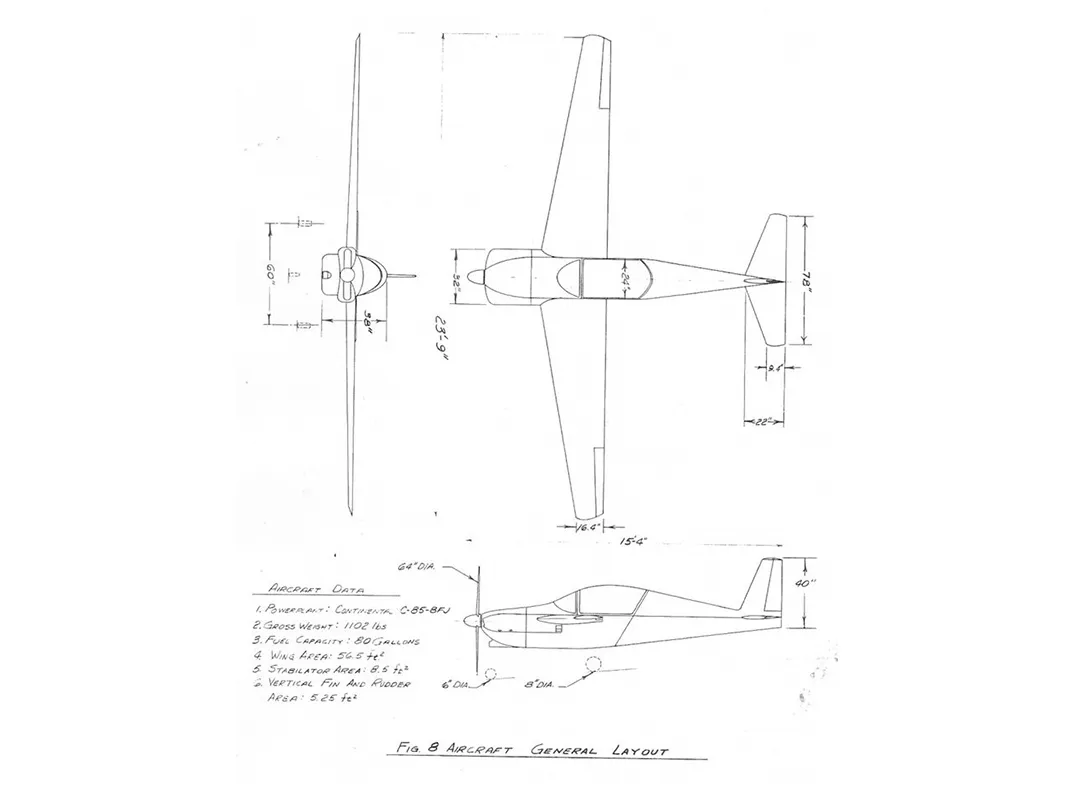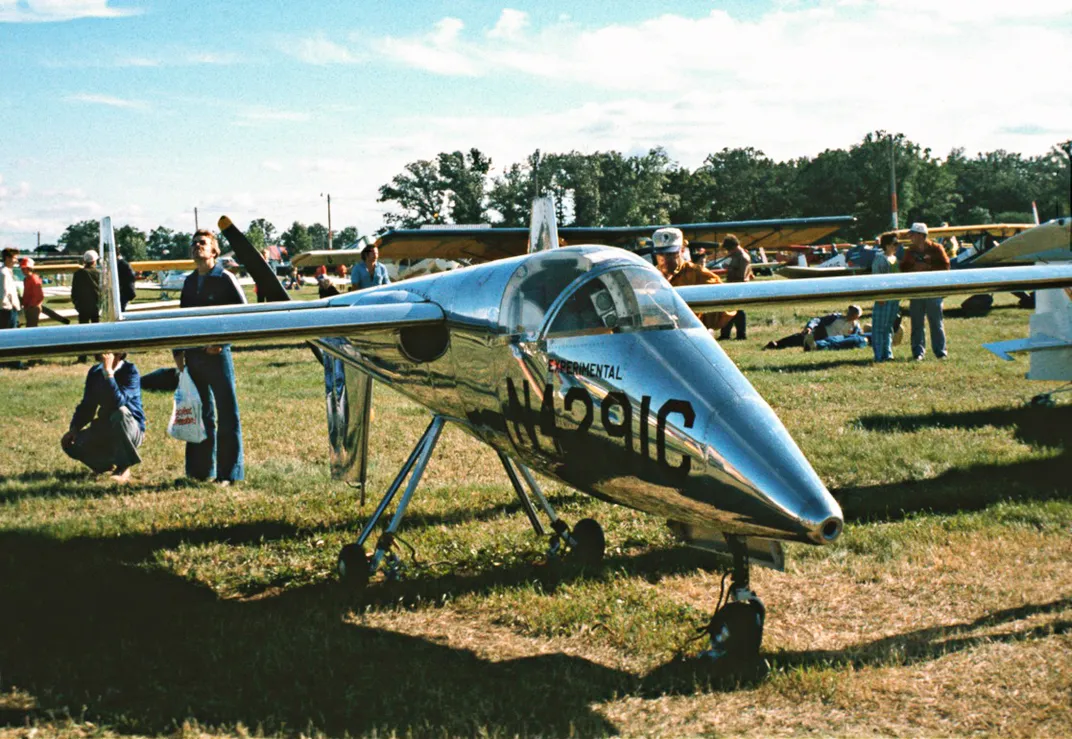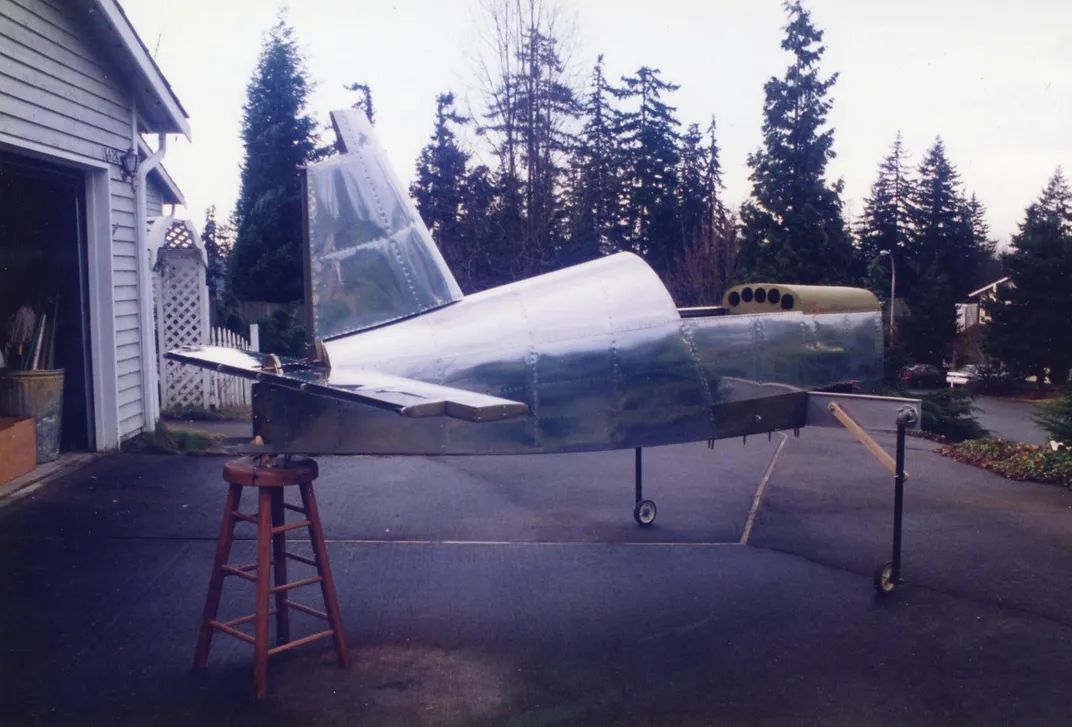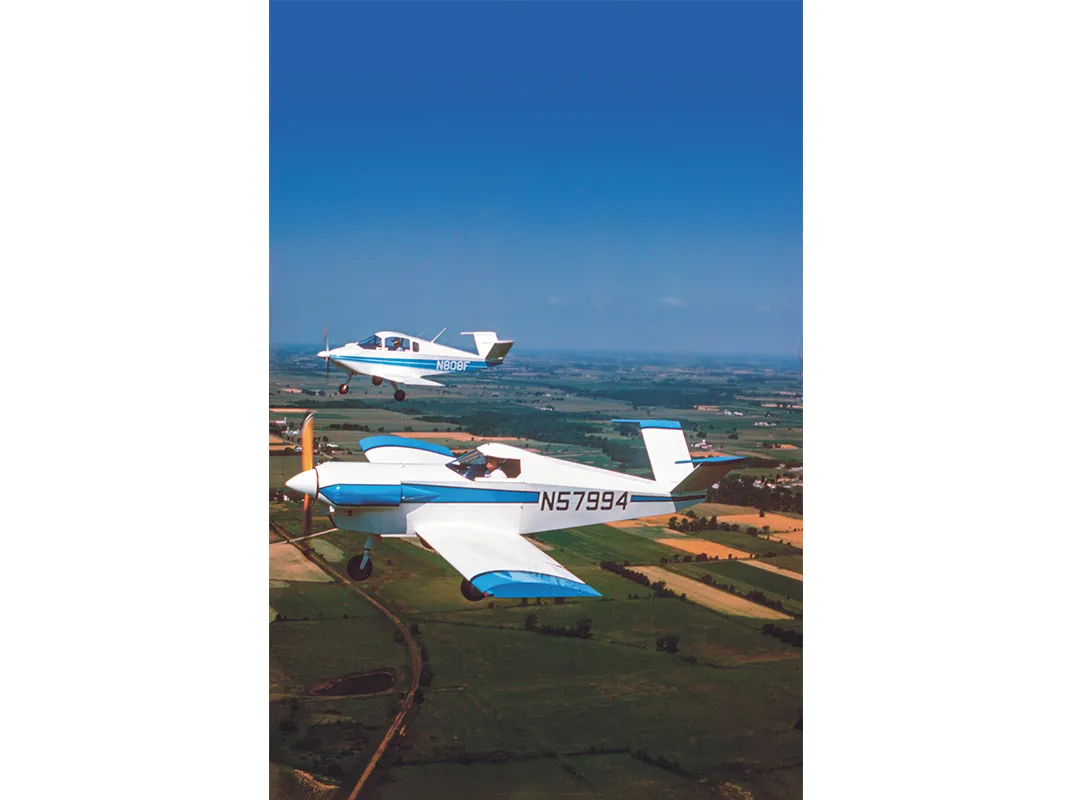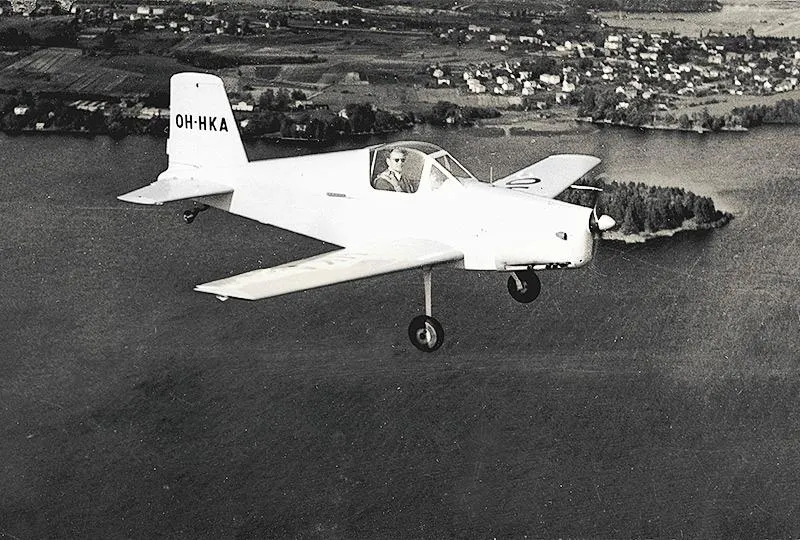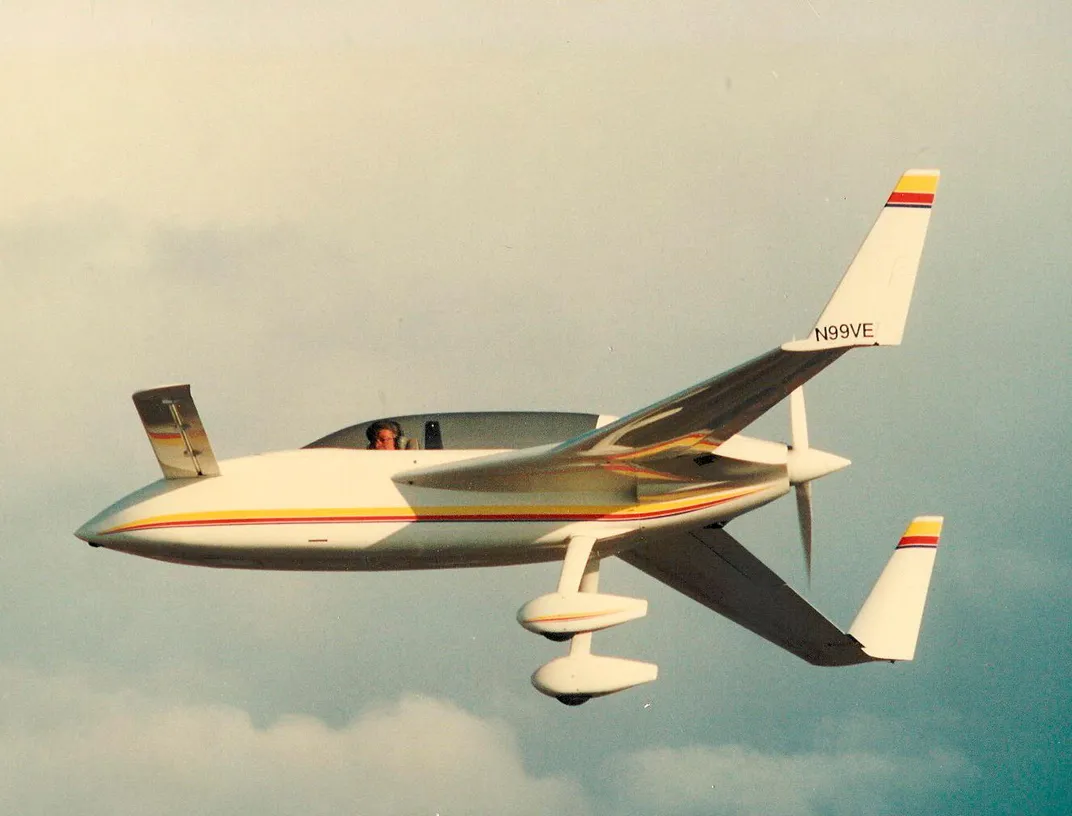Across the Continent in a Homebuilt
Some pilots build airplanes just to travel far.
/https://tf-cmsv2-smithsonianmag-media.s3.amazonaws.com/filer/e6/0f/e60f6aec-fa1e-4ced-b284-8e48b0ad4428/03h_fm2016_ebneterbjorkmane1landingharveyfield_live.jpg)
On a ramp at Paine Field in Everett, Washington, a crowd gathered around a small silver airplane. My 82-year-old father, Arnold Ebneter, called it the E-1, and he was confident that he was about to fulfill a 50-year-old dream: flying the E-1 nonstop for 2,328 miles to set a new world distance record. His airplane weighed exactly 1,102 pounds, just a few ounces short of the maximum allowed by the rules for the record, and carried only essentials: 59 gallons of fuel, two energy bars, and a quart of water. Though my dad built the E-1 at nearby Harvey Field, he thought the 2,900-foot runway there was probably too short. As he put a few gallons in the tank to make the hop over to Paine, his friends and colleagues at Harvey figured out what he was doing and made the drive over to Dad’s takeoff spot to join his family and wish him well.
At 2:15 p.m. on July 25, 2010, my father took off from Everett and headed east. During his climb to 9,500 feet, the altitude he needed to cross the Cascade Mountains, both his fuel gauge and fuel flow meter failed. For the next 18 hours, he would have to keep track of his fuel by multiplying the aircraft’s estimated burn rate by how long he’d been airborne. As he reached Montana, the sun set behind him and a line of thunderstorms at a safe distance provided a spectacular light show. A full moon rose and the radio fell silent. To help fight fatigue, he had designed his cockpit to be just roomy enough to let him fully straighten his legs above the rudder pedals for occasional stretches, and his seat reclined 30 degrees.
Passing through North Dakota, he ran into a headwind that slowed his progress and wasted precious fuel. He watched the sun rise in Indiana, and as he neared Columbus, Ohio, the E-1’s engine burned the last of the fuel in the wings, leaving only what was in the nine-gallon fuselage tank. Dad calculated he needed more than that to break the record. He did the math again, but the numbers refused to budge.
**********
Except for absolute records, which are open to any air and space vehicle, pilots seeking to set records compete in aircraft type and weight classes defined by the Fédération Aéronautique Internationale, based in Lausanne, Switzerland, the same organization that verifies record claims. Hundreds of records exist for airplanes in a wide array of categories, including altitude, speed, time to climb, duration, efficiency, payload, and distance. My father’s record attempt was for the farthest straight-line distance in a C-1a–class aircraft—that is, an aircraft, powered by an internal combustion engine that weighs less than 500 kilograms (1,102.3 pounds) when it takes off, so the total weight includes the aircraft, pilot, fuel, and cargo.
Like professional boxers, pilots will go to extreme lengths to stay inside a certain weight class. On the flight, they’ll minimize food, water, survival equipment, and even their own body weight to maximize fuel load. Some designers forgo lights and electrical systems, restricting their flight to daylight hours, and most take chances with weather by installing only minimal navigation equipment. Since a clear day across a long distance is a tall order, straight-line records are harder to set than those on a closed course—flying nonstop around a point half the distance away. Thus, in the distance category, the FAI recognizes only straight-line records for the prestigious Louis Blériot medal, which may be awarded each year to pilots who break distance, speed, or altitude records in light aircraft. Since inaugurating the medal in 1936, the FAI has given it out only 82 times, six to C-1a distance record-breakers. Four of those pilots took on an even greater challenge: designing and building the aircraft that would fly them the distance.
**********
On a hazy July day in 1957, K.H. Juhani Heinonen broke the C-1a distance record by flying 1,767 miles nonstop from Madrid, Spain, to Turku, Finland. The previous four C-1a record-setting pilots had flown factory-built aircraft; Heinonen was the first to build his airplane, an HK-1 Keltjäinen, from scratch.
Heinonen had originally designed the all-wood HK-1 as an aerobatic airplane; it had neither brakes nor an electrical system. To turn it into a record-setter, Heinonen added two fuel tanks. He chose a northward route to take advantage of a tailwind and the longer period of daylight near the Arctic Circle. After departing Madrid in cool air at 5 a.m., he climbed to 6,000 feet in order to cross the Pyrenees. Engine temperatures spiked as the airplane struggled with the heavy fuel load, but eventually returned to normal as he leveled out. After crossing the mountain range, clouds forced Heinonen to fly low for much of the trip, but he landed in Turku at 11 p.m., just before sunset, after flying for 17 hours.
Heinonen’s feat was covered in a short article in Jane’s All the World’s Aircraft. In 1960, Dad, a U.S. Air Force pilot and aeronautical engineering student at Texas A&M, read the article and thought, I wonder if I could do that? He set about designing an aircraft that could break the C-1a record for his senior project. The design won first place in a regional student competition sponsored by the American Institute for Aeronautics and Astronautics, but military and family responsibilities kept my father from building the airplane and attempting the flight.
While Dad got busy flying F-100s at bases around the world, Edgar Lesher, a professor of aerospace engineering at the University of Michigan, decided to attack Heinonen’s record. Lesher had worked at Douglas Aircraft in Santa Monica, California, in the 1930s. “Ed didn’t fit the usual mold [for an academic],” says Tom Adamson, a colleague at the university (Lesher died in 1998). “His focus was on building airplanes, not theoretical work.” Specifically, he was interested in building pusher aircraft, which have the propeller mounted behind the airplane’s engine. Compared to traditional tractor airplanes, in which a front-mounted propeller pulls the aircraft, a pusher offers better forward visibility and reduces drag from the propeller slipstream. In 1962, Lesher finished building a pusher called Nomad. He brought it to a fly-in where he learned about the C-1a record from another builder, Leeon Davis, who had designed the tiny aluminum DA-2 kitplane. Intrigued by the competition, Lesher decided to design an improved pusher. He called it Teal—it had a stencil of a duck on the fuselage next to the airplane’s name—to take on seven C-1a records in speed, altitude, and distance, including Heinonen’s.
Lesher had plenty of help, says Adamson: The professor recruited his design students to make performance calculations. And when a long shaft connecting Nomad’s engine to the propeller caused vibrations, Molt Taylor—who designed the 1949 flying car prototype Aerocar—recommended solving the problem with a special coupling that allows for smoother acceleration, which Lesher integrated into Teal’s design. The final version included a “wet wing” (able to carry fuel), an extra fuel tank behind the pilot, landing gear that could be retracted to reduce drag, and a compass for navigation.
Still, the aluminum Teal was heavy—680 pounds when empty, compared to the 551-pound HK-1 that held the record. However, due to lower drag, Teal flew faster. As for the pilot, Lesher explained in a 1967 article in Sport Aviation, “My first idea was to use a jockey.” Instead, the bulky aircraft gave him an incentive to lose a few pounds.
Teal first flew in 1965, and by 1970, Lesher had set six of the seven records. For the outstanding challenge, straight-line distance, he chose a westerly route from St. Augustine, Florida, that avoided high mountains and gave him four more hours of daylight than a west-to-east route. During his first attempts, in 1971, the weather cooperated, but in the days leading up to the flights, he was unable to sleep and canceled twice. A doctor prescribed medication, but it would be four years before Lesher got another chance.
On July 2, 1975, Lesher took off just after sunrise, equipped with a baseball cap, navigation charts, a canteen of water, and hard candy. To help fight boredom, he kept to a rigid schedule of computing ground speeds, recording data, and eating at 15-minute intervals. Around 12 hours into the flight, he crossed into Arizona and spotted a wall of thunderstorms in front of a mountain pass. He knew an airport lay 25 miles north, but it was short of the record. Lesher cut south, and soon he saw Tucson and improving weather in the distance. He landed at Phoenix’s Litchfield Park Airport, breaking Heinonen’s record by 68 miles.
At the 1975 Experimental Aircraft Association fly-in in Oshkosh, Wisconsin, just weeks after Lesher made his flight, Burt Rutan introduced the VariEze, a two-seat composite-material pusher that was lighter than Teal, although only the nose gear retracted. At the fly-in, Dick Rutan used his brother’s airplane to set a closed-course distance record.
Gary Hertzler, an engineer with Allied Signal (now Honeywell), had built a VariEze, and he thought he could improve on it. He tinkered with the exhaust system and air inlet, added a modified propeller that sacrificed climb performance to gain efficiency during cruise, and gave the airplane an exceptionally smooth finish. His version won several annual awards between 1982 and 1990 from the Competition for Aircraft Fuel Efficiency (CAFE) Foundation.
“The [fuel efficiency] competition made me aware of the airplane’s potential,” says Hertzler, and in July 1984, he flew to California to take on the C-1a distance records. First, he recruited Jeana Yeager as pilot to break Dick Rutan’s C-1a closed-course record. (In 1986, Yeager and Dick Rutan would fly the Voyager on the first nonstop unrefueled flight around the world.) While Rutan and Hertzler flew alongside in Rutan’s LongEze, Yeager cruised the round trip between Bakersfield and Merced, taking off at 6:40 p.m. and landing at 12:57 p.m. the next day.
Hertzler was ready to take on the straight-line record. After ferrying his airplane to the Rutans’ base in Mojave, he tried to get some sleep before his flight but failed. He took off at midnight carrying a half-gallon of water and a couple of granola bars. In addition to lights and an electrical system, he used a short-range radio navigation system. Hertzler followed Interstate 40 west and climbed to 11,500 feet to clear the relatively flat but high-elevation terrain in Arizona. He flew all night with no problems, but the following afternoon, clouds in Kentucky forced him to fly low. Sixteen hours into the flight, two sleepless nights and tangling with the weather had taken its toll. “I never felt drowsy,” Hertzler says. “But I was falling behind the airplane and my reactions were getting very poor.” He had enough fuel to cruise another few hundred miles, but chose to land at Martinsburg, West Virginia, where he broke Lesher’s record by almost 380 miles. He knew landing at Martinsburg was a good decision when he later saw the logbook entry he made right after landing: “My handwriting was very bad.”
Five decades after designing what he hoped would be a record-breaking airplane, my father, by then retired from the Air Force and well into a second career at Boeing in Seattle, was finally ready to make his record attempt. He started building the E-1 in 1993, using aluminum sheet metal from Boeing surplus. It had a front propeller and fixed landing gear. After the E-1’s first flight in 2005, Dad spent three years fixing fuel leaks, adding fairings to reduce drag, and trying different propellers in order to optimize speed. He also took advantage of miniaturized electronics to install a unit that offered GPS navigation, thunderstorm warnings, and a crude autopilot.
Like Hertzler, Dad sacrificed a few pounds to have lights and an electrical system. Since thunderstorms in the Midwest usually die down at night, he chose an afternoon takeoff from Seattle so he could cross the Midwest overnight and then land the next morning. Dad also had to comply with an FAI rule change: Instead of flying as far as he could and landing wherever he chose, as Lesher and Hertzler had done, he had to name his destination. He selected Shannon Airport in Fredericksburg, Virginia.
The E-1 was ready in 2009, but the weather didn’t cooperate. On the day he hoped to leave, fog blanketed Puget Sound, and the minimally equipped E-1 couldn’t fly through the thin layer to reach the clear skies. Finally, in July 2010, after a year of waiting for his schedule and the weather to match up, everything came together. Other than the fuel gauge problems after takeoff, Dad says the flight was mostly relaxing, but sometimes lonely. Overnight, no one was talking on the radio, not even traffic controllers. “About two in the morning, I could have believed I was the only person left awake in the United States,” he says. “In North Dakota and Montana, I really felt isolated because there were hardly any lights on the ground.”
After learning the bad news about his fuel status near Columbus, my father chose not to surrender. With clearer weather forecast ahead, he climbed back to 7,500 feet and found a tailwind that carried him the rest of the way. As he entered the traffic pattern outside Fredericksburg, he thought, After all these years, this is really happening, and it turned out just like I thought it would. When he landed, Dad had covered 2,328 miles in 18 hours and 15 minutes. He had enough fuel to fly another 50 miles. Dad claims he wasn’t tired, but Art Greenfield, the FAI official who met the E-1 as it landed in Virginia, says my father’s first words were “I’m never doing that again.”
Dad knows he’ll likely surrender the record to someone else eventually. Homebuilt aircraft light enough to fly farther already exist—Leeon Davis built a 445-pound DA-5 that held the closed-course record Yeager broke with Hertzler’s modified VariEze. The current owner of Davis’ DA-5, Larry Oros, says the airplane still weighs only about 475 pounds, but he has no plans to attempt any records with it. Regardless, with Dad’s flight already longer than 18 hours, the ultimate limit to breaking the record may be human, not aeronautical.
Hertzler still owns his VariEze, which he has further modified to improve its performance, while also learning a lesson that test pilots know well: Tinkering with an aircraft to push the envelope carries risks. Not long after his record-breaking flight, Hertzler tried out some cylinders he designed, and the engine failed on takeoff. He managed to land on a taxiway with minimal damage, and after repairs, used the airplane in 1993 to take the C-1a closed-course distance record from Yeager. He says, “I might still have another record in me,” but also says that he has no plans to take the straight-line distance title from my dad.
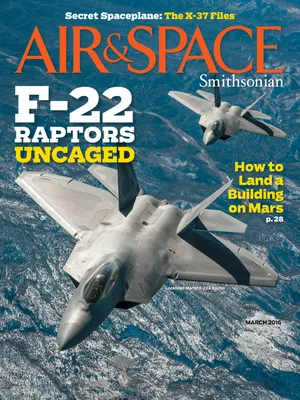
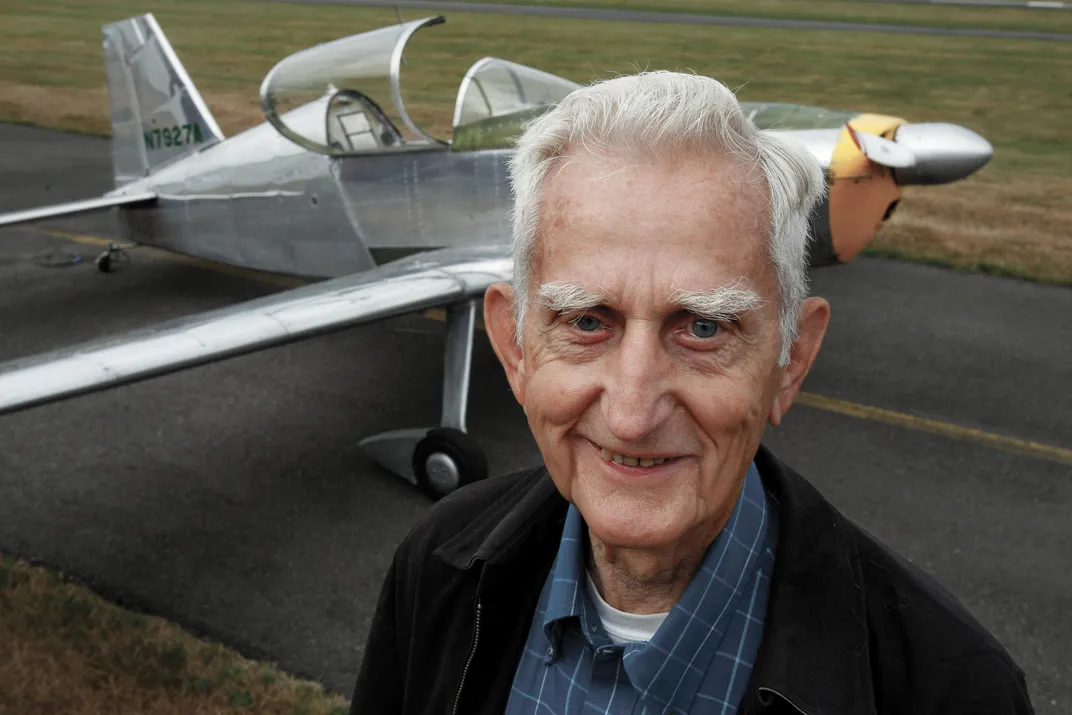
/https://tf-cmsv2-smithsonianmag-media.s3.amazonaws.com/filer_public/49/a9/49a92e4b-3bf0-4ba8-a8c9-41386049a039/03f_fm2016_hertzlerscan0037_live-web-resize.jpg)
/https://tf-cmsv2-smithsonianmag-media.s3.amazonaws.com/filer_public/e8/8d/e88d2618-ac3a-4334-b297-892e594247f3/03i_fm2016_map.jpg)
